| |
Here and There, Then and Now
Friday, February 1, 2008, 3:23 AM GeneralPosted by stefanie It's strange to think that we've been in Japan long enough to be talking about renewals, but here we are. Matthew's residency status expires in March, only two months from now. His contract is up for renewal in April. My residency status expires in June. We intend to renew everything for another year because our lives here aren't finished yet. Even so, there's something that makes me wish we were making plans to go back to America instead.
Life in Japan is very rewarding. We both enjoy our work, we're making friends, and we love Kitakami. The hard things of six months ago have become today's commonplace, almost second-nature things. Even on the worst days, a look around at the mountains brings a sense of serenity that I don't remember feeling in a very long time. What can I say, I'm a westerner. Mountains go a long way with me.
Still, the approach of a natural transition point causes me to think about the things I miss about America. Washington doesn't have mountains, but it does have its own grandeur. Every day of the eight years that I traveled downtown for school, work, or leisure, I saw the Capitol dome. And it never got old. We spent many an autumn afternoon windsurfing on the Eastern Shore, stopping for a rockfish sandwich and a pint on the way home. I miss the contented feeling of driving down the GW Parkway, confident in our ability to navigate to any destination, despite the completely blinkered signage. It took us years to figure that mess out.
I miss Jazzercise, the Vie, the U Street dining tour, and the patio at Les Halles. I miss Woodside and the Swedewagon. I miss American Idol!
For all that I miss, though, I know that there are more new adventures in store for us here. There's more to learn, more to overcome, more keys to lose and reports to file, and more stories to have for when we do return to America, feeling nostalgic for Kitakami.
[ 4 comments ] permalink
On Sunday, we went bowling as part of a group event. Bowling in Japan is no different from bowling in the States, down to the clownish rental shoes.  We haven't gone bowling in a very long time, so it took us a few frames to get back into it. Our team actually did pretty well ¡½ three of us broke 100 on the first game, and we all did on the second. The event was a fundraiser for the local sign language club, some of whom we've met through local friends. In between turns, they were teaching us little bits of Japanese Sign Language, including the signs for "Washington" and "America." As it turns out, the frowny face accompanying a blown spare is an international sign. At the end of the tournament, the group gave prizes to each participant, ranked from highest score to lowest; I think we were all in the top twenty. Also, people who threw gutter balls had the dubious distinction of getting extra prizes based on the number of gutters thrown. Matthew got one: 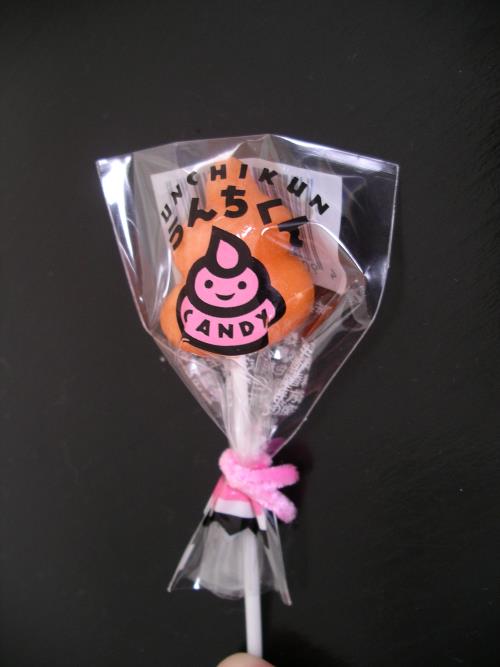 Yes, it's candy poop on a stick. A lollipoop, if you will.
As a kid, I never fully understood Snoopy's paralyzing fear of the icicle over his doghouse. I saw plenty of icicles, and they just weren't big enough to kill a cartoon dog. Now, I understand. I've had the experience of looking up to see a four-foot gleaming needle dangling above, ready to break free and plunge through my heart at the least provocation. On the bright side, I haven't actually seen any icicles breaking free unprovoked. But I do find myself checking above before walking under an eave. The four-footers are ubiquitous, but dwarfed by some eight-to-ten-foot icicles we spotted. You really don't want to be hanging out under these. 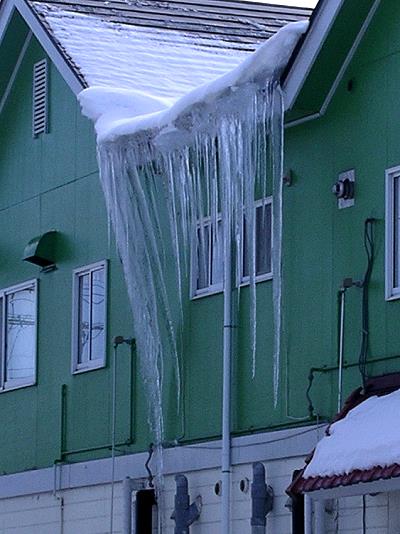 Meanwhile, the house across from ours has just the right roof slope, at just the right angle to the sun, to produce horizontal icicles: 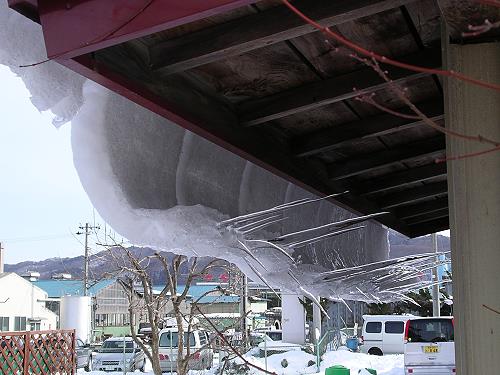 These are not actually dangerous, but they sure look like they're ready to fly off and perforate the building walls, don't they? Now if only I could get someone to use a pizza to entice me to safety...
You can find almost anything your heart desires in vending machines in Japan: soda, beer, hot canned soup, 10-kilo bags of rice. . . 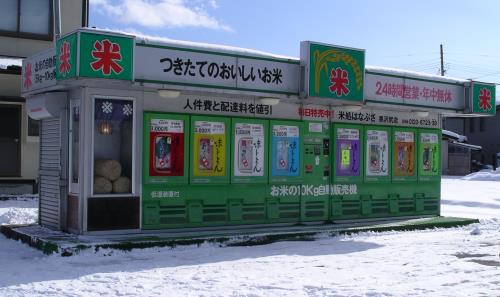 This machine has gotten some play before, courtesy of the late, great, Kitakami Photoblog ( Konnichiwa, Julia- san!).
[ 5 comments ] permalink
Thursday, January 24, 2008, 6:54 PM GeneralPosted by stefanie According to our local friends, January 21 was Daikan ¡½ the coldest day of the year on the Japanese calendar. The two weeks surrounding Daikan are also supposed to be colder than the rest of winter, which is easy to believe. Many roads in town resemble skating rinks because temperatures have gotten just above freezing during the day, but it hasn't been warm enough to evaporate the snowmelt. Riding your bike on these roads is quite treacherous; I've taken some spills in the last week or so.
The Japanese have different ways of dealing with winter weather than we've experienced in America. It's common to see cars sitting with their windshield wipers standing out. People do this so that they won't freeze to the windshield, which totally makes sense if you've ever tried to prise frozen rubber away from glass. In Kitakami, street crews don't salt or sand the roads ¡½ driving precautions are up to individuals. Almost everyone has snow tires or chains. Roads aren't graded down to the asphalt. As far as we can tell, they're not really graded at all, but harvested. Snow is clearly removed from them because the level on the roads is lower than that in yards and parking lots, but a layer is still there and there aren't piles of gray, dirty snow lining the streets. The result is that even two or three weeks after a big snowfall, the landscape is still quite beautiful, if the roads are a bit more dangerous than we're used to. It's not a bad trade-off.
[ 1 comment ] permalink
Tuesday, January 22, 2008, 2:36 PM GeneralPosted by stefanie On Saturday, the Kitakami International Assembly Hall hosted its Shinnenkai, an introduction to Japanese culture. Attendees could try out a range of traditional activities, from tea ceremony to shodou (Japanese calligraphy) to koto (Japanese zither). Matthew is interested in learning shodou, so he got a quick lesson. 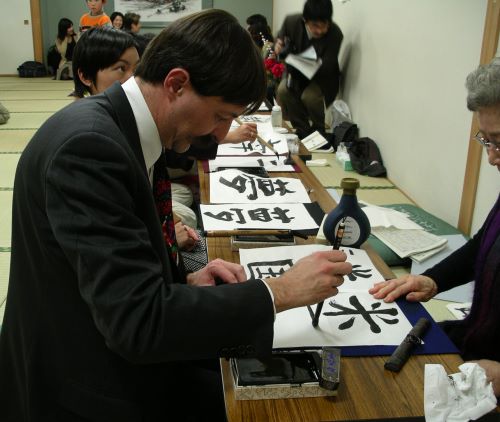 We also tried koto and shakuhachi, Japanese bamboo flute. Our trial was featured in a photo in the Sunday newspaper, which unfortunately is not available online. Each group also put on a demonstration. The tea ceremony practitioners prepared the traditional New Year's tea, which contained a pickled plum and a tied bit of seaweed. The tea was served with youkan and black bean and walnut mochi. 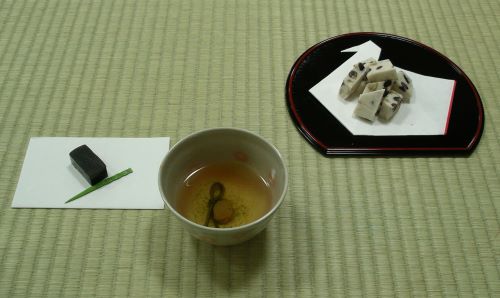 One of the more energetic groups performed a type of Japanese street entertainment. They chanted a folk tale while dancing with props resembling small bamboo fences that they could manipulate into different forms. 
New Year's in Japan seems to be an ongoing celebration throughout the month of January. Shinnenkai, or New Year's gatherings held after January 1, bring people together to share in the optimism of the fresh year ahead and to partake in traditional events. We were invited to one such event last week, mochitsuki. As we've mentioned before, mochi is one of the traditional Japanese New Year's foods. Mochitsuki is the traditional mochi-making ceremony, during which members of the community use large wooden mallets to pound polished, cooked rice into a sticky paste. Once the paste is made, it is formed into small cakes, which can then be eaten. At the encouragement of our hosts, we took a turn kneading the mochi with the giant mallets. 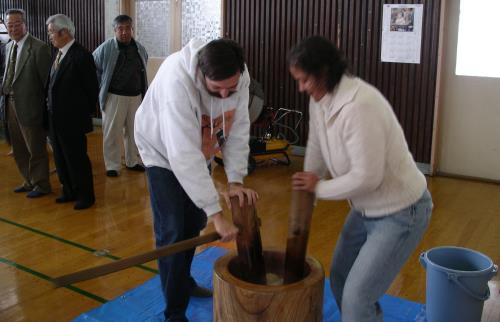 It was fun, but we clearly lacked the energy and expertise of the locals. 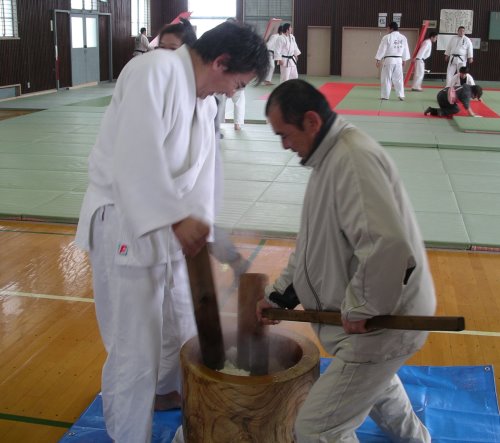 Once the kneading was completed, people alternated pounding the rice with a quick water rinse to keep it from sticking to the equipment. Children, assisted at times by their parents, got in on the pounding too. It was a great community event; one that we're glad we went out into the white-out conditions for.
Strawberry Fields for Winter
Last weekend, I had to make dessert for a dinner party. Wanting to do something with fruit, I headed to the produce section, thinking about citrus or maybe pears. Those thoughts were blown out of my head by the sight of row upon row of . . . bright red strawberries. And a big sign proclaiming the arrival of the "Strawberry Fair." In Japan, winter is the high season of the strawberry. Strawberries sit in little boxes in displays at the front of the store, announcing their provenance and price ("Fresh Strawberries from Sendai! 680 yen!"), drawing attention away from all the other fruits. Every patisserie sets out an array of strawberried treats ¡½ filled, topped, stuffed with jam, you name it. Strawberry KitKats, strawberry danish, and strawberry eclairs are everywhere. Traditional sweets, like daifuku ( anko-filled mochi balls) contain strawberries at this time of year, too. The prominence of strawberries in January is very strange to me because, as for most Americans, strawberries scream "summer!" It seems somehow wrong to see them everywhere when we're still rocking our snowboots every day. A bit of research revealed that in many parts of Japan, strawberries alternate with rice as a part-of-the-year crop, so it's not completely out of the question that they would be reaching peak over the winter months. In fact, the strawberries we've eaten were grown in Japan and were quite delicious. On the other hand, it makes me think: perhaps the strawberry producers are in cahoots with the weathermen ("If we sell strawberries during the winter, they'll make people think of summer! They'll forget that the temperature hasn't gotten above freezing in six days, and all will be right as rain!).
J-Life Lesson #46: When living in a part of the country where it snows every day during the winter, check frequently on your air-drying laundry. 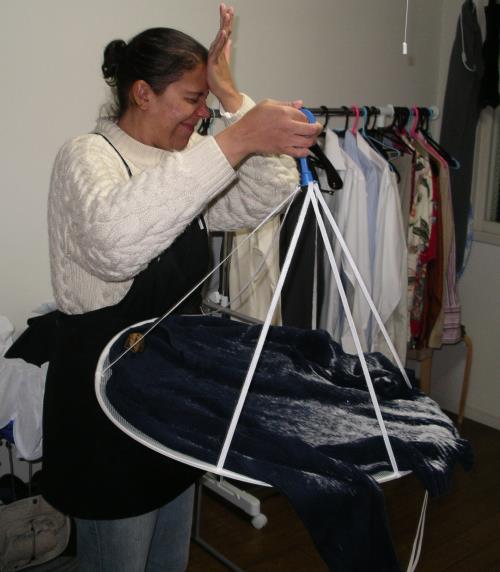
Let's take a look at today's weather, shall we? Here's the weather report. It's pretty typical for winter in Tohoku: snow in the morning, and cloudy all day after that. 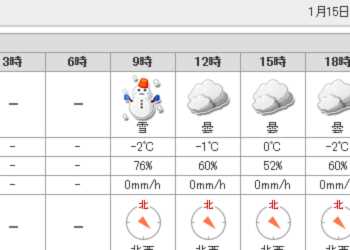 Now, let's take a look out the window: 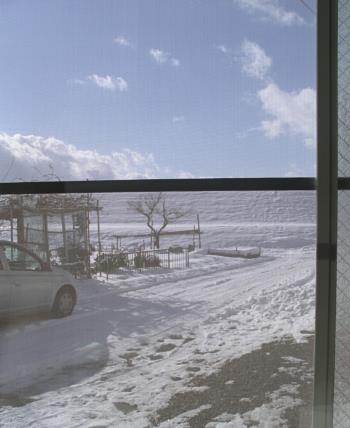 That's about how it goes with the weather forecasts here. They aren't just inaccurate, they're willfully dishonest, or at least it seems so. My theory is that the weathermen are part of a secret government program to emotionally control the people and prevent revolt. When it's nice out (or will be), the forecast shows nasty weather, so that everyone gets a pleasant surprise and is happy. When it's nasty out, the forecast shows nice weather tomorrow or the next day, which gives people hope (even though the nice weather doesn't actually arrive until three weeks later).
Back Next
|
|













 Calendar
Calendar




